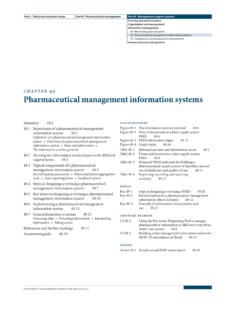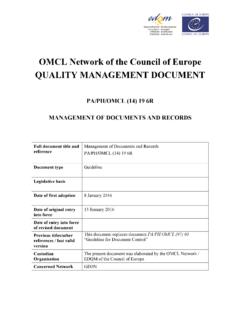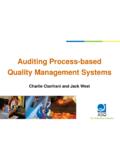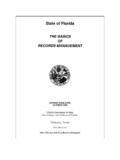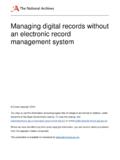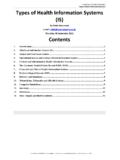Transcription of OECD DRAFT ADVISORY DOCUMENT 16 THE …
1 DRAFT OECD Guidance DOCUMENT 16 September 2014 1 OECD DRAFT ADVISORY DOCUMENT 161 THE APPLICATION OF GLP PRINCIPLES TO COMPUTERISED SYSTEMS FOREWARD 1. The following DRAFT ADVISORY DOCUMENT will replace the 1995 OECD GLP Consensus Doc-ument number 10 - The Application of the Principles of GLP to Computerised Systems. The original DOCUMENT 10 was developed by the OECD Working Group on GLP, based on a DOCUMENT emanating from a 1992 workshop held in Switzerland. The current DRAFT ADVISORY DOCUMENT , also developed by the Working Group, retains all of the key text from the original Consensus DOCUMENT 10 where changes were unnecessary, but also includes new text to reflect the current state-of-the art in this field.
2 This DRAFT will be revised based on the input received during the public comment period. PREAMBLE 2. This DOCUMENT introduces a life-cycle based validation approach, emphasizing risk assess-ment as the central element of a scalable, economic and effective validation approach. The intention is to give regulatory guidance in developing an adequate validation strategy for any type of computerised system in a GLP environment regardless of its complexity. 1. GENERAL Scope and definition of terms 3. All computerised systems used for the generation, measurement or assessment of data in-tended for regulatory submission should be developed, validated, operated and maintained in ways which are compliant with the GLP Principles.
3 4. During the planning, conduct and reporting of studies there may be several computerised systems in use for a variety of purposes. Such purposes might include the direct or indirect capture of data from automated instruments, operation/control of automated equipment and the processing, re-porting and storage of data. For these different activities, computerised systems can vary from a pro-grammable analytical instrument, or a personal computer to a laboratory information management sys-tem (LIMS) with multiple functions. Whatever the scale of computer involvement, the GLP Principles should be applied. 5. This guidance applies to all types of computerised systems used in GLP regulated activities.
4 A computerised system is a set of software and hardware components which together fulfill certain functionalities. Hardware is the physical components of the computerised system ; it will include the computer unit itself and its peripheral components. Software is the programme or programmes that control the operation of the computerised system . All GLP Principles which apply to equipment there-fore apply to both hardware and software. 1 This DOCUMENT would replace OECD Consensus DOCUMENT No 10: The Application of the Principles of GLP to Computerised Systems (1995) DRAFT OECD Guidance DOCUMENT 16 September 2014 2 6. Computerised systems should be of appropriate design, adequate capacity and suitable for their intended purposes.
5 There should be appropriate procedures to control and maintain these systems, and the systems should be developed, validated and operated in a way which is in compliance with the GLP Principles. 7. The demonstration that a computerised system is suitable for its intended purpose is of fun-damental importance and is referred to as computer validation. 8. The validation process provides a high degree of assurance that a computerised system meets its pre-determined specifications. Validation should be undertaken by means of a formal validation plan and performed prior to operational use. 9. This guidance regulates any computerised system , regardless of its complexity (it covers the range from simple devices like balances to complex systems like laboratory information management systems).
6 Validation is required for the process or a sub-process performed by a computerised system . Validation should only be carried out on qualified IT infrastructure. The process should be reliable and able to perform according to the intended purpose based on qualified hardware and software. 10. The validation approach should be life cycle based giving the regulated user the freedom to choose any life cycle model. The regulated user s life cycle approach should entail defining and per-forming activities in a systematic way from conception, understanding the requirements, through de-velopment, release, operational use, to system retirement. Life cycle activities should be scaled based on justified risk assessment decisions.
7 Minimal activities might be required for simple processes like weighing on a stand-alone balance; more extensive activities might be required for complex systems like interfaced laboratory information management systems. 11. Validation of newly established computerised systems should be done prospectively. Validation should include testing and change control within the production environment. Retrospec-tive validation should be carried out for existing systems (legacy systems) that have become GLP rele-vant. Guidance for the validation of legacy systems is given by PIC/S PI 11-3 Good Practices for Computerised Systems in Regulated GxP Environments [effective ].
8 Risk Assessment 12. Risk assessment should be applied throughout the life cycle of a computerised system taking into account data integrity and the quality of the study results. Decisions on the extent of validation and data integrity controls should be based on a justified and documented risk assessment. It should interact with other relevant procedures ( configuration and change management, data manage-ment). 13. Risk assessment may be part of a test facility s risk management system . It should be a key instrument to develop an adequate validation strategy and to scale the validation efforts. The validation effort should be driven by the intended GLP relevant use of the system and its risks to data quality and integrity.
9 The outcome of the risk assessment processes should result in the assignment of appropriate validation activities to computerised systems or computerised system functionalities. This is of para-mount importance for an effective validation approach and economic (scaled) validation decisions giv-ing the regulated user an adequate instrument to validate simple laboratory systems as well as complex laboratory data management systems properly. 14. Dual use system (have both GLP and non-GLP uses and functions) would still require devel-opment, validation, operation, and retirement under GLP change control and security. DRAFT OECD Guidance DOCUMENT 16 September 2014 3 Personnel, roles and responsibilities 15.
10 The GLP Principles require that a test facility has appropriately qualified and experienced personnel and that there are documented training programmes including both on-the-job training and, where appropriate, attendance at external training courses. Records of all such training should be maintained. The provisions should also apply for all personnel involved with computerised systems. 16. Management of a test facility has the overall responsibility for compliance with the GLP Principles. This includes the responsibility to establish policies and procedures to ensure that comput-erised systems are validated in order to demonstrate that systems suit their intended purpose and are operated and maintained in accordance with the Principles of GLP.










